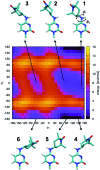High-resolution measurement of long-range distances in RNA: pulse EPR spectroscopy with TEMPO-labeled nucleotides
- PMID: 29997809
- PMCID: PMC6005265
- DOI: 10.1039/c5sc04631a
High-resolution measurement of long-range distances in RNA: pulse EPR spectroscopy with TEMPO-labeled nucleotides
Abstract
Structural information at atomic resolution of biomolecular assemblies, such as RNA and RNA protein complexes, is fundamental to comprehend biological function. Modern spectroscopic methods offer exceptional opportunities in this direction. Here we present the capability of pulse EPR to report high-resolution long-range distances in RNAs by means of a recently developed spin labeled nucleotide, which carries the TEMPO group directly attached to the nucleobase and preserves Watson-Crick base-pairing. In a representative RNA duplex with spin-label separations up to 28 base pairs (≈8 nm) we demonstrate that the label allows for a model-free conversion of inter-spin distances into base-pair separation (Δbp) if broad-band pulse excitation at Q band frequencies (34 GHz) is applied. The observed distance distribution increases from ±0.2 nm for Δbp = 10 to only ±0.5 nm for Δbp = 28, consistent with only small deviations from the "ideal" A-form RNA structure. Molecular dynamics (MD) simulations conducted at 20 °C show restricted conformational freedom of the label. MD-generated structural deviations from an "ideal" A-RNA geometry help disentangle the contributions of local flexibility of the label and its neighboring nucleobases and global deformations of the RNA double helix to the experimental distance distributions. The study demonstrates that our simple but strategic spin labeling procedure can access detailed structural information on RNAs at atomic resolution over distances that match the size of macromolecular RNA complexes.
Figures






Similar articles
-
Study of a DNA Duplex by Nuclear Magnetic Resonance and Molecular Dynamics Simulations. Validation of Pulsed Dipolar Electron Paramagnetic Resonance Distance Measurements Using Triarylmethyl-Based Spin Labels.J Phys Chem B. 2016 Jun 16;120(23):5125-33. doi: 10.1021/acs.jpcb.6b03193. Epub 2016 Jun 3. J Phys Chem B. 2016. PMID: 27195671
-
A distance ruler for RNA using EPR and site-directed spin labeling.Chem Biol. 2004 Jul;11(7):939-48. doi: 10.1016/j.chembiol.2004.04.013. Chem Biol. 2004. PMID: 15271352
-
DNA with Parallel Strand Orientation: A Nanometer Distance Study with Spin Labels in the Watson-Crick and the Reverse Watson-Crick Double Helix.J Phys Chem B. 2015 Oct 29;119(43):13593-9. doi: 10.1021/acs.jpcb.5b02935. Epub 2015 Jul 10. J Phys Chem B. 2015. PMID: 26121221
-
Inter- and intra-molecular distances determined by EPR spectroscopy and site-directed spin labeling reveal protein-protein and protein-oligonucleotide interaction.Biol Chem. 2004 Oct;385(10):913-20. doi: 10.1515/BC.2004.119. Biol Chem. 2004. PMID: 15551865 Review.
-
Toward an Expanded Genome: Structural and Computational Characterization of an Artificially Expanded Genetic Information System.Acc Chem Res. 2017 Jun 20;50(6):1375-1382. doi: 10.1021/acs.accounts.6b00655. Epub 2017 Jun 8. Acc Chem Res. 2017. PMID: 28594167 Free PMC article. Review.
Cited by
-
Cu2+-based distance measurements by pulsed EPR provide distance constraints for DNA backbone conformations in solution.Nucleic Acids Res. 2020 May 21;48(9):e49. doi: 10.1093/nar/gkaa133. Nucleic Acids Res. 2020. PMID: 32095832 Free PMC article.
-
Pulse EPR Measurements of Intramolecular Distances in a TOPP-Labeled Transmembrane Peptide in Lipids.Biophys J. 2016 Dec 6;111(11):2345-2348. doi: 10.1016/j.bpj.2016.10.022. Epub 2016 Nov 9. Biophys J. 2016. PMID: 27836102 Free PMC article.
-
2'-Alkynyl spin-labelling is a minimally perturbing tool for DNA structural analysis.Nucleic Acids Res. 2020 Apr 6;48(6):2830-2840. doi: 10.1093/nar/gkaa086. Nucleic Acids Res. 2020. PMID: 32052020 Free PMC article.
-
Posttranscriptional site-directed spin labeling of large RNAs with an unnatural base pair system under non-denaturing conditions.Chem Sci. 2020 Aug 20;11(35):9655-9664. doi: 10.1039/d0sc01717e. eCollection 2020 Sep 21. Chem Sci. 2020. PMID: 33224460 Free PMC article.
-
Orientation and dynamics of Cu2+ based DNA labels from force field parameterized MD elucidates the relationship between EPR distance constraints and DNA backbone distances.Phys Chem Chem Phys. 2020 Dec 7;22(46):26707-26719. doi: 10.1039/d0cp05016d. Phys Chem Chem Phys. 2020. PMID: 33159779 Free PMC article.
References
-
- Ha M., Kim N. V. Nat. Rev. Mol. Cell Biol. 2014;15:509–524. - PubMed
LinkOut - more resources
Full Text Sources
Other Literature Sources

